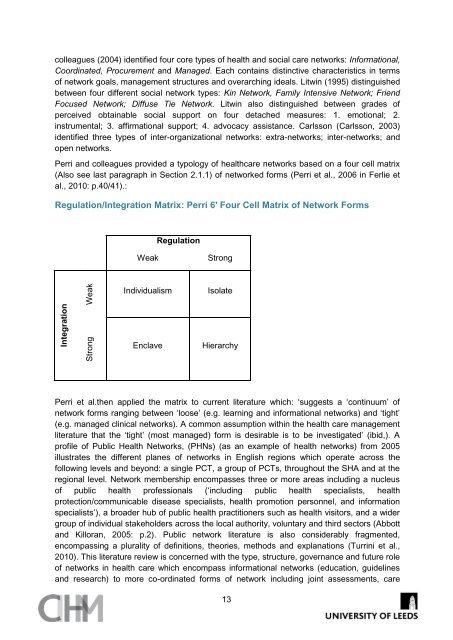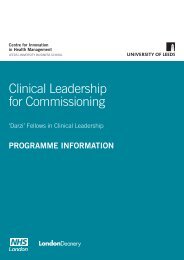IntegrationWeakStrongcolleagues (2004) identified four core types of health and social care networks: In<strong>for</strong>mational,Coordinated, Procurement and Managed. Each contains distinctive characteristics in termsof network goals, management structures and overarching ideals. Litwin (1995) distinguishedbetween four different social network types: Kin Network, Family Intensive Network; FriendFocused Network; Diffuse Tie Network. Litwin also distinguished between grades ofperceived obtainable social support on four detached measures: 1. emotional; 2.instrumental; 3. affirmational support; 4. advocacy assistance. Carlsson (Carlsson, 2003)identified three types of inter-organizational networks: extra-networks; inter-networks; andopen networks.Perri and colleagues provided a typology of healthcare networks based on a four cell matrix(Also see last paragraph in Section 2.1.1) of networked <strong>for</strong>ms (Perri et al., 2006 in Ferlie etal., 2010: p.40/41).:Regulation/Integration Matrix: Perri 6' Four Cell Matrix of Network FormsRegulationWeakStrongIndividualismIsolateEnclaveHierarchyPerri et al.<strong>the</strong>n applied <strong>the</strong> matrix to current literature which: ‘suggests a ‘continuum’ ofnetwork <strong>for</strong>ms ranging between ‘loose’ (e.g. learning and in<strong>for</strong>mational networks) and ‘tight’(e.g. managed clinical networks). A common assumption within <strong>the</strong> health care managementliterature that <strong>the</strong> ‘tight’ (most managed) <strong>for</strong>m is desirable is to be investigated’ (ibid,). Aprofile of Public <strong>Health</strong> <strong>Networks</strong>, (PHNs) (as an example of health networks) from 2005illustrates <strong>the</strong> different planes of networks in English regions which operate across <strong>the</strong>following levels and beyond: a single PCT, a group of PCTs, throughout <strong>the</strong> SHA and at <strong>the</strong>regional level. Network membership encompasses three or more areas including a nucleusof public health professionals (‘including public health specialists, healthprotection/communicable disease specialists, health promotion personnel, and in<strong>for</strong>mationspecialists’), a broader hub of public health practitioners such as health visitors, and a widergroup of individual stakeholders across <strong>the</strong> local authority, voluntary and third sectors (Abbottand Killoran, 2005: p.2). Public network literature is also considerably fragmented,encompassing a plurality of definitions, <strong>the</strong>ories, methods and explanations (Turrini et al.,2010). This literature review is concerned with <strong>the</strong> type, structure, governance and future roleof networks in health care which encompass in<strong>for</strong>mational networks (education, guidelinesand research) to more co-ordinated <strong>for</strong>ms of network including joint assessments, care13
pathways, managed clinical networks (or often no binding contract at all). Irani noted howhealth care networks broadly encompass:1. Clinical Association: this is an in<strong>for</strong>mal group that corresponds or meets to considerclinical topics, best practice or o<strong>the</strong>r areas of interest2. Clinical Forum: this is a more <strong>for</strong>mal group that meets regularly, focuses on clinicaltopics and <strong>for</strong>mulates jointly agreed clinical protocols3. Developmental Network: this is a clinical <strong>for</strong>um with broader focus o<strong>the</strong>r than purelyclinical topics, with emphasis on service improvement4. Managed Clinical Network: this network includes function of a Clinical Forum and hasa <strong>for</strong>mal management structure with defined governance arrangements and specificobjectives (Irani, 2011: p.4).O<strong>the</strong>r networks include client based networks (Provan and Milward, 2001) carer networks(Abel et al., 2011), personal clinical networks (Sokolovsky et al., 1978), person-centrednetworks (Wellman, 1999) and clinical education networks (Guilbert et al., 2004). There arealso procurement networks (Perri et al., 2006) and <strong>the</strong> traditional highly managed networksof partners who provide and co-ordinate care <strong>for</strong> whole populations (Smith, 2010). Allen andMervyn (Allen and Mervyn, 2012: <strong>for</strong>thcoming) validate <strong>the</strong> work of o<strong>the</strong>rs (Pettigrew, 1999,Pettigrew, 2000, Pettigrew et al., 2001, Fisher et al., 2004, Counts and Fisher, 2008, Fisheret al., 2010, Chatman, 1991, Chatman, 1996, Chatman, 1987) who found that underservedpeople in complex environments are more inclined to embrace inter-personal networks andunconventional sources as opposed to hierarchical, top-down sources associated with publicservice providers.This literature review is proposed as a means of understanding <strong>the</strong> nature of networks, within<strong>the</strong> context of <strong>the</strong> public sector and healthcare, and <strong>the</strong>ir objectives, relationships andpremise in <strong>the</strong> current healthcare climate (with a particular interest in future trends), and mayinvariably help to enhance <strong>the</strong> value of investments in <strong>the</strong> various health programs (Maysand Smith, 2011). .Research has explored <strong>the</strong> emergence of networks with public, private partnerships (PPPs),(Angelopoulos, 2010), and a: ‘...PPP can be conceptualized as a network in whichstakeholders are interacting nodes that establish <strong>for</strong>mal as well as in<strong>for</strong>mal relationships’(p.3). However: [CIHM] do not equate partnership working with networking as this may leadto erroneous conclusions. Nei<strong>the</strong>r do we intend to explore public health per se; ra<strong>the</strong>r,healthcare networks are of prime concern.1.2.2 Network Characteristics i<strong>Networks</strong> are quite unlike random graphs; ra<strong>the</strong>r, real networks are ‘non-random in somerevealing ways that suggest both possible mechanisms that could be guiding network<strong>for</strong>mation, and possible ways in which we could exploit network structure to achieve certainaims’(Newman, 2003: p.9). Many observers have attempted to define networks through anadapted version of O’Toole’s (1997) explanation: ‘…structures of interdependence involvingmultiple organizations or parts <strong>the</strong>reof, where one unit is not merely <strong>the</strong> <strong>for</strong>mal subordinate of<strong>the</strong> o<strong>the</strong>rs in some larger hierarchical arrangement’ (p.45). O’Toole specifically defined anetwork as a: ‘... pattern of two or more units, in which not all <strong>the</strong> major components are14
- Page 1 and 2: Centre for Innovation in Health Man
- Page 3 and 4: 2.4 Agency Networks, Policy Network
- Page 5 and 6: ‘Networks can take many forms to
- Page 7 and 8: of the parts.based uponintegrity.Ho
- Page 9 and 10: Why theyfailIf it struggles toachie
- Page 11 and 12: Table 2: Examples of NetworksManage
- Page 13: 1.1.3 The scoping methodologyA brai
- Page 17 and 18: in terms of a shared vision, common
- Page 19 and 20: Rangachari (Rangachari, 2008) took
- Page 21 and 22: Turrini et al (2009) also raise fou
- Page 23 and 24: Trying things out: just taking some
- Page 25 and 26: Success is attributed/dependant on
- Page 27 and 28: 2.2 Developmental NetworksCharacter
- Page 29 and 30: transaction costs. Also: ‘...the
- Page 31 and 32: The authors acknowledge that the mo
- Page 33 and 34: Research has explored regional clus
- Page 35 and 36: Networks are essentially a form of
- Page 37 and 38: significant social bonds and joint
- Page 39 and 40: 3 Network Evaluation and Future of
- Page 41 and 42: contractual relationships; the arra
- Page 43 and 44: to meet the legal and policy based
- Page 45 and 46: Sectors Networks (PSNs) are underst
- Page 47 and 48: coordinated manner, unconstrained b
- Page 49 and 50: Research has shown that there is no
- Page 51 and 52: perhaps are used as a way to avoid
- Page 53 and 54: attempted to determine (section 1.2
- Page 55 and 56: Leadership, 2, 147-163.BOURDIEU, P.
- Page 57 and 58: DOUGHERTY, T. W., CHEUNG, Y. H. & F
- Page 59 and 60: other social media are reshaping he
- Page 61 and 62: NHS SCOTLAND. 2010. Review of nine
- Page 63 and 64: mental patients in a Manhattan SRO
- Page 65 and 66:
AppendixPrinciples of engagement (M
- Page 67 and 68:
NHS Networks: The document (NHS NET
- Page 69 and 70:
iPrinciples of engagement (MENDIZAB
- Page 71 and 72:
• frequently updated - not live,
















